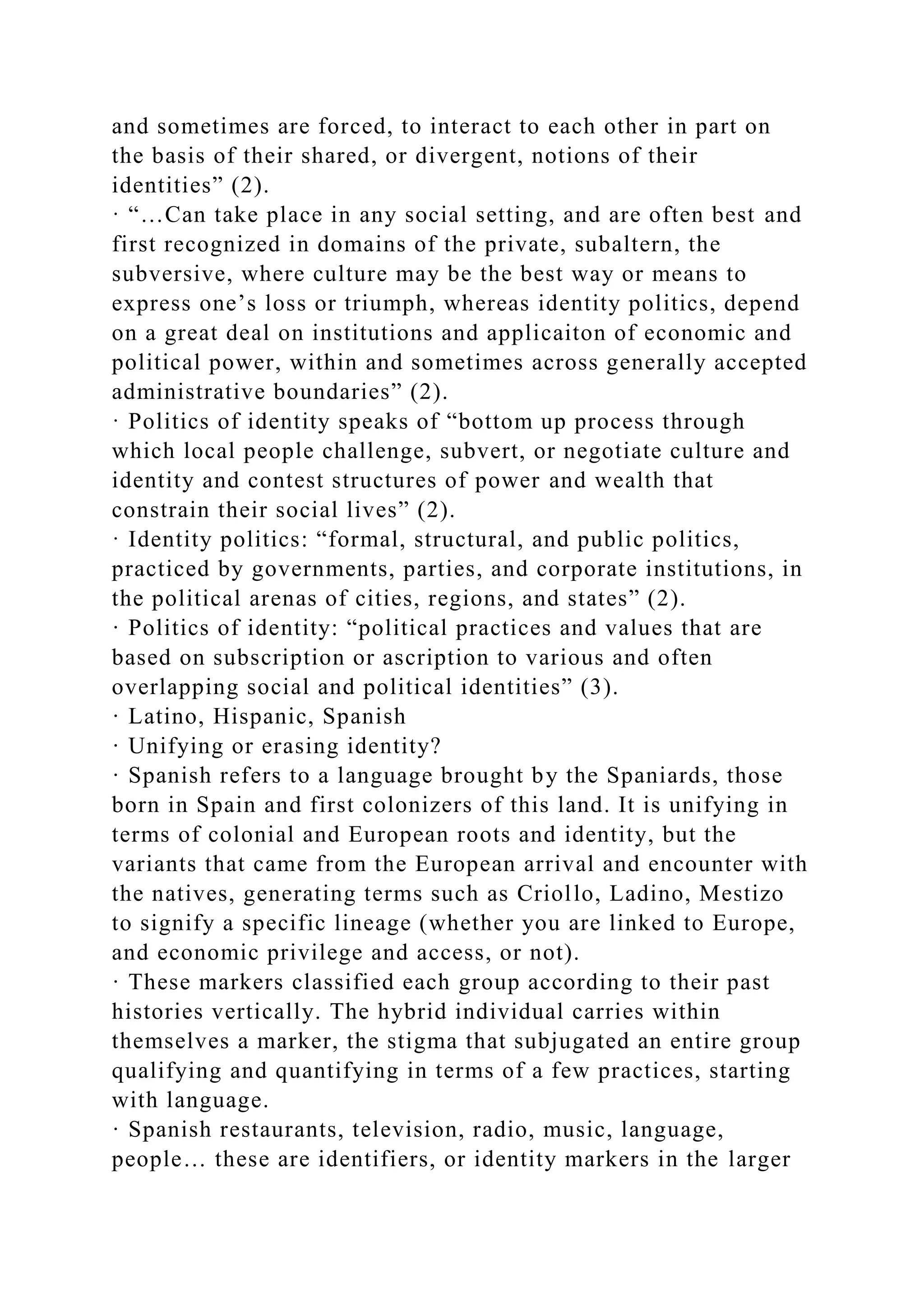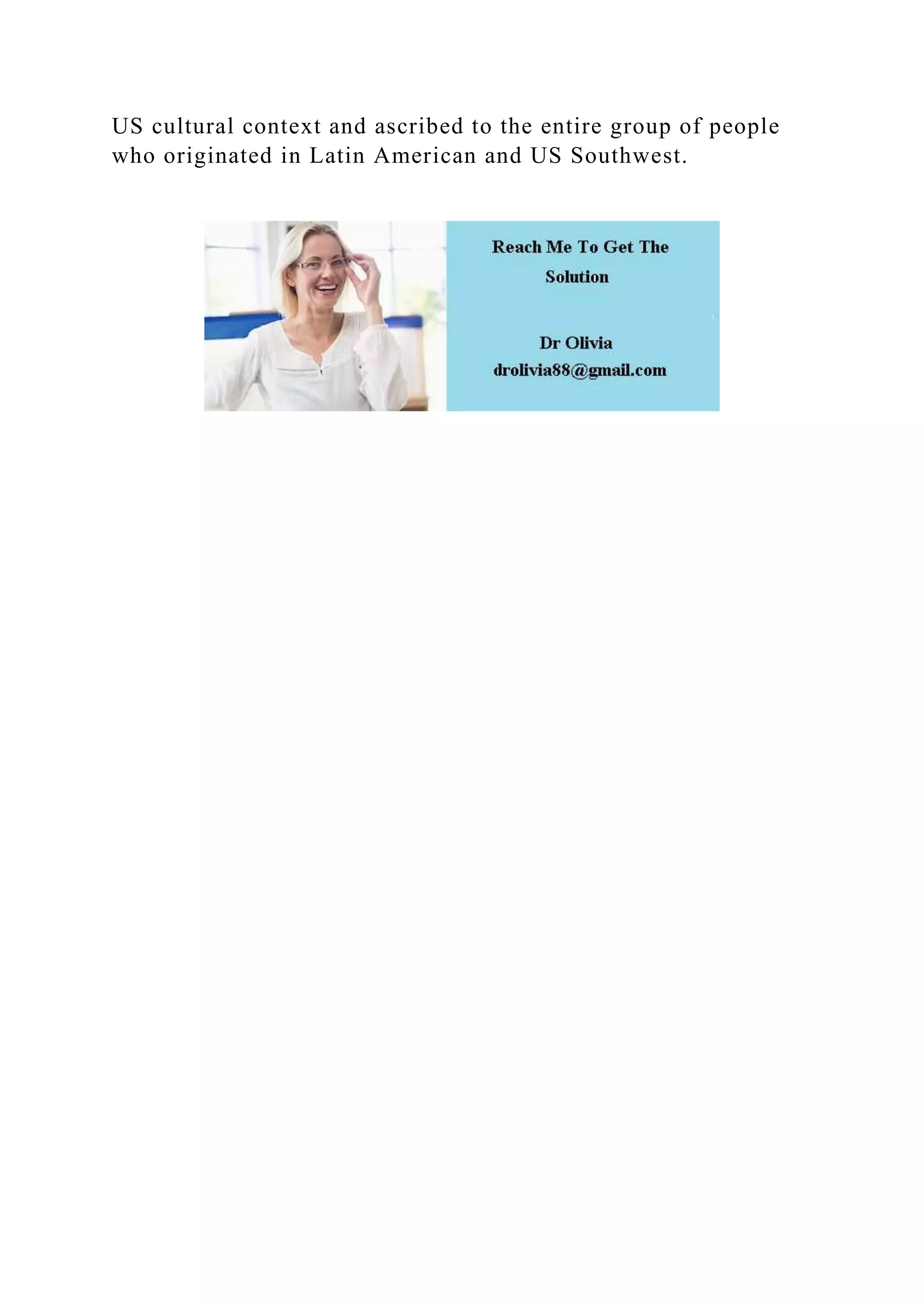The document discusses identity politics and the social construction of identity, emphasizing the relational aspects of identity and how cultural contexts shape individual and group identities. It explores how identities are asserted in political processes, the impact of social hierarchies, and the complexities immigrant experiences create in defining identity. Furthermore, it highlights the tensions between individual agency and social context, as well as the role of power and stigma in identity formation and negotiation.


![That context includes cultural notions of what is normal and
desirable or valued –
As well as what is abnormal, stigmatized, undesirable
· Rhetoric of choice
Renders a group invisible
People's unequal access to all kinds of resources, is taking into
account
Who has and who lacks the Power to define “normal”
· concepts
· Michel Foucault’s concepts of ‘discipline’ and ‘power’
· Embodiment
· Inscription
· Relational
· The social construction of identity
· Sees identity not as something inside the individual but as a
social relationship – this is the relational aspect of identity
· Fredrik Barth defined ethnicity as "the social organization of
cultural difference."
· Ethnicity places individuals within a group based on shared
cultural practices, language, and often national origin; the
shared ethnicity creates a fictitious tie between people of the
same ethnicity that will be recalled at a moment when the group
is challenged based on their ethnicity.
· “Mental reality … [is] the meaning people assign to their
actions” (Liah Greenfeld, quoted Tilly, p3).
· “Nationalism, for Greenfeld, exists when people subject to a
common political authority share consciousness of belonging to
a distinctive sovereign community” (Tilly, p4).
· National identification leads to “a shared sense of dignity,
efficacy, and relative equality among the nation’s members,
hence a new willingness to undertake economic beliefs” (Tilly,
p4).
· Inclusion and belonging
· Imply exclusion
· Us/them
· We define ourselves in relation to the Other](https://image.slidesharecdn.com/identitypoliticsandthepoliticsofidentityauthorsinthis-221015122846-15f31389/75/IDENTITY-POLITICS-AND-THE-POLITICS-OF-IDENTITY-Authors-in-this-docx-3-2048.jpg)

![cultural accommodation undertaken by immigrants and their
children
· Internal migration and border crossing
· Crossing physical borders provides differential access to
transportation, jobs, services, and housing.
· Crossing psychological borders implies leaving the home
country with a set of cultural values and norms, and with a
specific understanding of self and nation. The immigrant brings
within an identity developed within these cultural contexts.
· In the process of adapting to the new country, the immigrant
engage in an accommodation process and they will slowly (or
rapidly in case of children) that they belong to a small group, to
the minority, that is bounded by a larger group, or white
dominated majority.
· "Racism and xenophobia shape both the meaning and social
value attributed to [their] ethnic identities and to their lived
experience of national belonging in the contemporary US
society," (Suzanne Oboler, "It must be a fake! Racial
ideologies, identities, and the question of rights" in
Hispanics/Latinos in the United States: Ethnicity, race, and
rights, 2000, pg.127)
· For Latinos the adaptation process is complicated by US's long
history of discrimination against and exclusion of their
community.
· The word Latino tends to group together a diverse cultural
group. It is an artificially constructed group and the term itself
implies an erasure of this diversity, and homogenizes creating
an illusion of unity, common history, language, ideologies, and
practices. It implies that Latinos are a social group that
originated in Latin America.
· Iris Young defines social groups as "a collective of persons
differentiated from others by cultural forms, practices, special
needs or capacities, structure of power, or privilege… [This is]
less some set of attributes its members share than the relation in
which they stand to others," ("Structure, difference and
Hispanic/Latino claims of justice," in Hispanics/Latinos in the](https://image.slidesharecdn.com/identitypoliticsandthepoliticsofidentityauthorsinthis-221015122846-15f31389/75/IDENTITY-POLITICS-AND-THE-POLITICS-OF-IDENTITY-Authors-in-this-docx-5-2048.jpg)
![United States, 2000, pg. 153)
How a group member identify themselves affects the ways in
which they relate to larger collectivities, such as their racial
group in the US.
Identity then, as Judith Howard defines pertains to "a group
[that] is constituted not only when all members share the same
characteristics with one another, but also when the members
stand in a particular relationship to nonmember," ("Social
Psychology of Identities" in Annual Review of Sociology 26
(2000) 367-93).
This is a relational understanding of identity that attempts to
bridge the individual level and contextual aspects of identity
formation.
It acknowledges the cognitive aspects of identity while also
situating identity processes in their social context in order to
see people as a whole, and in the process recognizing that our
everyday lives and experiences within a particular culture in
which we operate shape our senses of who we are and what we
can become.
· For Latinos the sense of 'who we are' and 'what we could
become' is profoundly influenced by the experiences of
crossing, and not being able to cross, multiple borders, and we
must situate our specific experiences at the intersection of
power, collective identities, place, and history.
· We must focus on structure, agency, and power to understand
that the process of accommodation occurs in a stigmatized
context, and how the exercise of power is a key aspect of
stigma.
· Stigma is imposed on the individual and differentiates from
discrimination in the forms they are experienced:
· Discrimination refers to denial of benefits, concrete negative
experiences
· Stigma refers to imposed characterizations, based on real or
imagined attributes that convey a social identity and which is
devalued in a particular social context. Stigmas are often based
on essentialist ideas of behavior.](https://image.slidesharecdn.com/identitypoliticsandthepoliticsofidentityauthorsinthis-221015122846-15f31389/75/IDENTITY-POLITICS-AND-THE-POLITICS-OF-IDENTITY-Authors-in-this-docx-6-2048.jpg)


